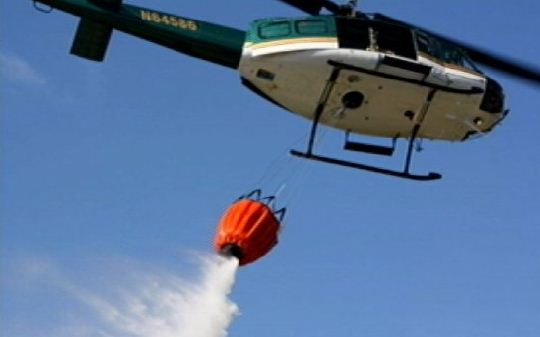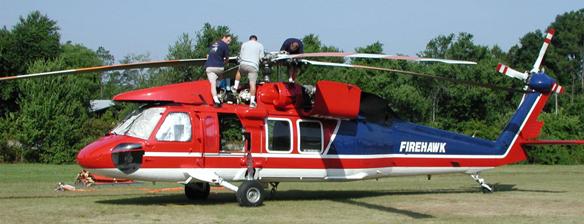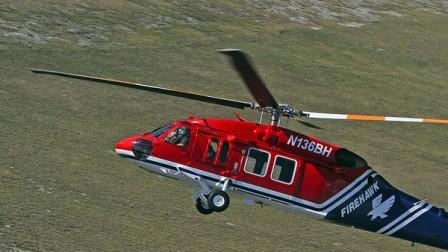Here is an interesting video about the use of aerial ignition on a prescribed fire on the Mark Twain National Forest in Missouri.
Tag: helicopter
In Canada, competition for helicopter contracts is tough

An article at VerticalMag.com laments the state of the charter helicopter industry in Canada. The slowdown in the economy has made competition for helicopter contracts fierce in the fields of wildland firefighting, mineral exploration, oil and gas exploration, and heli-tourism. Here is an excerpt from the article.
…With some 220 companies operating 1,752 commercial helicopters (a 34 percent increase since 2001), observers say there are now too many aircraft chasing too little work.
[…]
Wildland Firefighting
When it comes to wildland firefighting, contracts rates have been dropping as a result of the abundant supply of intermediate and medium helicopters idled by the decline in mining, oil and gas, and forestry work. For example, AS 350B2s were recently contracted by the Alberta government for $1,090 an hour and AS 350B3s for $1,290 an hour — when the normal casual-hire rates for these helicopters in the oil patch have been running in the $1,800- to $2,495-an-hour range.
When it comes to new innovations, a potential game changer is VIH’s Sikorsky S-61 helitanker concept: two were introduced to the B.C. Ministry of Forests last summer, before they were shipped to Australia for that country’s fire season. The S-61 helitanker concept features an Isolair 3,800-liter (1,000 US gallon) belly tank, which can be refilled in 40 seconds. B.C. has historically used fixed-wing retardant bombers and bucket-equipped helicopters, but the province is evaluating other options after incurring some extreme fire seasons in recent years.
“The S-61 has the ability to put more water on a fire per hour that other methods, said VIH’s Woytkiw. Another recent firefighting development is VIH’s selection of a Simplex water bucket for the heavy-lifting Kamov Ka-32, which Woytkiw called “bulletproof and very durable.”
Thanks Dick
New requirements could be expensive for operators of firefighting helicopters

Some new requirements for Call When Needed (CWN) helicopters that are hired for temporary firefighting duty may be expensive for some contractors. In order to qualify for a U. S. Forest Service CWN contract, the new specifications require each Type 3 CWN helicopter, such as a Bell 206, to have wire-cutting kits (designed to help protect the aircraft if it runs into power lines), strobe lights, a heated defroster unit, and a specific type of cargo hook. The changes are supposed to enhance safety and promote standardization. According to contractors quoted in an article in the Washington Examiner, it could cost from $10,000 to $50,000 for each helicopter.
This could be a tough decision for a CWN operator to make. If they spend the money, they may or may not get called to perform any work for the USFS, since CWN resources are only used if the existing full time exclusive use aircraft are not sufficient to handle the work load.
Helicopters drop water on Japan’s nuclear reactors
Some very brave helicopter pilots made some water drops on the melting down nuclear reactors in Japan on Thursday. Two CH-47 helicopters operated by Japan’s Self-Defense Forces made four drops on Reactors three and four at the Fukushima Daiichi nuclear power facility in an attempt to cool down the out of control reactors.
The audio in this video is distorted, but the images are OK.
According to a report, lead plates were attached to the bottom of the helicopters and the pilots were wearing protective suits in order to minimize their exposure to radiation. They also dropped from a fairly high altitude and at speed, rather than a hover, to reduce their exposure. The pilots are being limited to 40 minutes of flight time each day.

The pilots may be risking their lives doing this. Of course dropping water on vegetation fires is routine for experienced pilots and may be an adrenalin rush, but flying a few hundred feet over a melting down nuclear reactor is a whole different level of risk.
During the Chernobyl nuclear accident in 1986, helicopters were used to drop 5,000 metric tons of bags containing sand, lead, and boric acid onto the burning reactor. One of the helicopters collided with a large construction crane killing the four-person crew.
Helicopter’s Bambi bucket lost in lake

When the pilot flying the Charlotte County (Florida) Sheriff’s Office helicopter began to lift off from a lake after filling the Bambi bucket with water while helping to suppress a vegetation fire on Wednesday February 27, he noticed that something was missing — the bucket. Caused by either an equipment malfunction or the pilot accidentally hitting the wrong button, the bucket detached from the helicopter and disappeared into the murky water below.
Now it is sitting on the bottom of the lake while dive teams search by feel in the near-zero visibility water. The bucket was purchased pre-owned, but a new replacement would cost about $20,000 according to Charlotte County Sheriff Bill Cameron.
Fighting wildfire with Blackhawk helicopters

When I was working on the Blackjack Bay Complex in Georgia and Florida in May of 2002 we had a privately-owned Blackhawk helicopter assigned to the fire that was named “Firehawk”, as you can see in the above picture.
The Orlando Sentinel has an interesting article about Firehawk Helicopters Inc., a subsidiary of Brainerd Helicopters of Leesburng, Florida. Here is an excerpt:
Smaller, less-expensive helicopters typically make the initial attack when a wildfire breaks out. Heavy lifters such as a Firehawk, typically hired by the U.S. Forest Service for thousands of dollars an hour, turn out for the biggest, scariest fires.
The Black Hawk is fast, cruising at 160 mph and topping out at nearly 200. At 11,000 pounds empty and twice that loaded, it weighs four times as much as a typical police helicopter. Brainerd’s fuel trucks are labeled “Prey for the Hawk.”
His Black Hawks hoist 900-gallon buckets to unload their water on fires. A few rotorcraft can carry more — but none more safely than the Firehawks. Their seats flex as much as 12 inches to absorb the shock of a crash that could otherwise break a pilot’s back.
“That’s Chuck’s way of doing things,” said George Custer, a Forest Service incident commander. “All contractors want to be safe, but not all of them invest the kind of money that Chuck has invested in his tools.”
Chuck Brainerd had quit yanking timber out of swamps in 1977. The helicopter he had then wasn’t so trustworthy. “I was beginning to feel like every day could be my last.”
He quit transporting heart patients in 1986. “It felt good to help people, but it just wasn’t what I wanted to do.”
He found a better chopper, outfitted it as an airborne firetruck and went to a California blaze. That chaotic first day in September 1987 jarred him. “I thought, ‘Chuck, you’re in over your head.’ ”
Days later, Brainerd managed a difficult drop, soaking a smoldering tree. Ground crews cheered. “I thought, ‘Wow, I hit it.’ Then I was hooked and knew that I wanted to do it for the rest of my life.”
He flew to Yellowstone National Park a year later for the famous inferno that scorched the nation’s psyche and more than one-third of the park’s acreage.
He bought his first Black Hawk in 1995, then another, and then teamed with Brown Helicopters of Pensacola for three more.
All came pre-owned, including one from the Sultan of Brunei with gold-plated door handles still attached, and another from Hong Kong’s harbor patrol with machine-gun mounts still affixed.
Because Black Hawks and replacement parts are hard to get, it can be more challenging for the Brainerds than for the average copter company to keep the fleet in the air.
But Brainerd is a believer in the Army’s choice of aircraft: If the Black Hawk can survive bullet strikes and hard landings, it’s more than able to wage war on wildfires. National Guard units sometimes deploy their Black Hawks to forest fires; Los Angeles County bought two of them for firefighting.
The Brainerds’ copters, now reconditioned, reconfigured and repainted, might sell for $10 million each. It’s hard to say, because few such machines ever come on the market.
Until recently Firehawk Helicopters was the only private company in the country operating Blackhawks. Now, according to the Firehawk Helicopters web site:
Brainerd Helicopters and Brown Helicopters have teamed up.
Now located at Brainerd Helicopters facility in Leesburg, FL are three Sikorsky S-70A Black Hawks, owned by Brown Helicopters. These Black Hawks are going through an extensive inspection process, and are going to be equipped with the same avionics, mission equipment, and fire fighting capabilities as our original two Firehawks. For more information about this important development follow this Link.


Here is a video featuring the Firehawks:
Continue reading “Fighting wildfire with Blackhawk helicopters”
